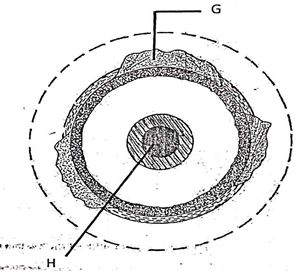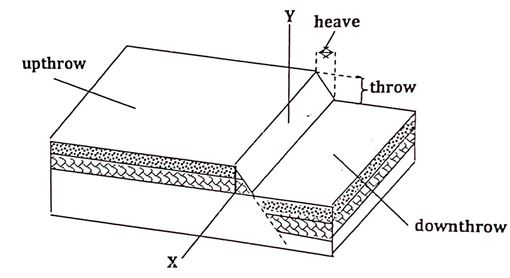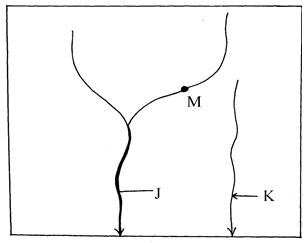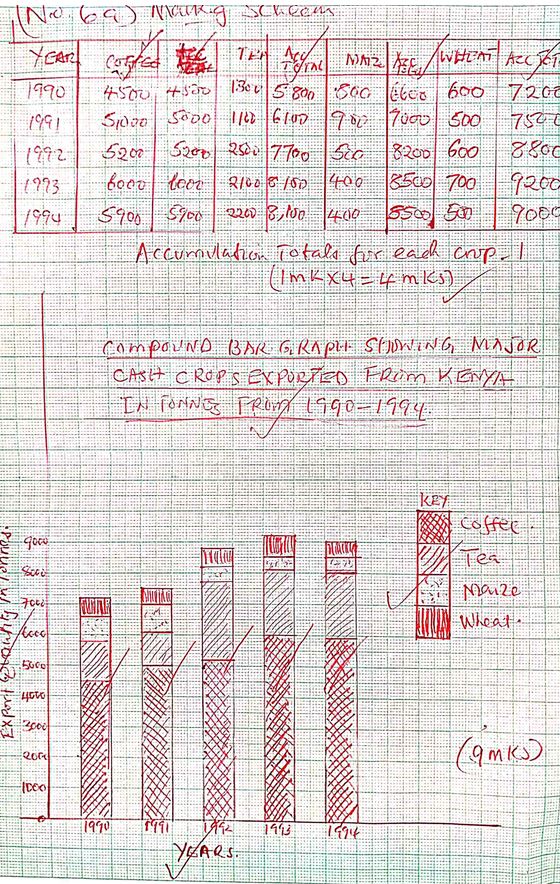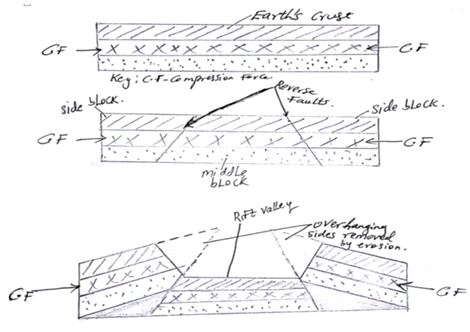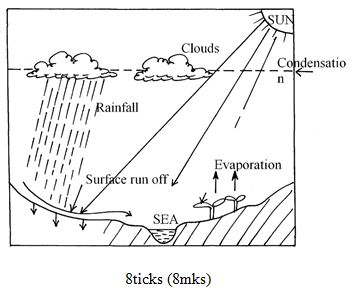Questions
INSTRUCTION TO STUDENTS
- Answer all Questions
- This paper contain two sections
- Student should answer the question in English.
SECTION A
-
- Give four areas that are of great interest in physical geography. (4mks)
- Outline three ways in which a student benefits from learning Geography. (3mks)
- The diagram below shows the internal structure of the earth.
- Name the parts marked G and H. (2mks)
- Name the dorminant mineral in the mantle. (1mk)
-
- Differentiate between absolute and relative humidity. (2mks)
- State the significance of humidity in the atmosphere. (3mks)
- The diagram below shows some features formed by faulting
- Name the parts marked X and Y. (2mks)
- State three effects of faulting on drainage of an area. (3mks)
-
- What is weathering. (2mks)
- State three agents of weathering. (3mks)
SECTION B
Answer all Question in this section.
- The table below shows hypothetical figure of major crops exported from Kenya in tonnes.
YEAR COFFEE TEA MAIZE WHEAT 1990 4500 1300 800 600 1991 5000 1100 900 500 1992 5200 2500 500 600 1993 6000 2100 400 700 1994 5900 2200 400 500 - Using scale 1cm represent 1000tonnes draw a compound bar graph showing major crops exported from Kenya in tonnes. (13mks)
- Give four possible analyses one could be deduce from the graph you have drawn. (4mks)
- Give four advantages of compound bar graphs. (4mks)
- State four disadvantages of compound bar graph. (4mks)
-
-
- Distinguish between minerals and rocks. (2mks)
- State three characteristics of minerals. (3mks)
- Name three types of minerals. (3mks)
-
- Describe how intrusive Igneous rocks are formed. (5mks)
- State three characteristic of intrusive rocks. (3mks)
-
- What is rock metamorphism. (2mks)
- State three factors that influence rock metamorphism. (3mks)
- Explain two economic benefits of coral limestone rocks. (4mks)
-
-
- Describe how block disintegration occur in weathering. (5mks)
- Explains how the following factors influence weathering.
- Time. (2mks)
- Nature of the rocks. (4mks)
- Action of plants. (3mks)
- Your class carried out a field study on the effects of weathering along the school compound.
- State two objective for your study. (2mks)
- State two effects of weathering on the physical environment you are likely to identify. (2mks)
-
- Define the term mass wasting. (2mks)
- State three storage processes of water on the earth surface. (3mks)
- Define the term river. (2mks)
-
-
- Name two types of earth movements. (2 marks)
- State three causes of earth movement. (2 marks)
- Describe the plate tectonics theory. (5 marks)
-
- Define faulting. (2 marks)
- State three factors that may influence faulting processes. (3 marks)
- Name four types of faults. (4 marks)
- With the aid of well-labelled diagrams, describe the formation of rift Valley by compressional forces. (7 marks)
-
-
- What is river rejuvenation (2mks)
- Study the diagram below and answer the questions that follow.
- Identify the process represented by the diagram above (1mk)
- Label the parts marked J and K (2mks)
- Identify the type of erosion that take place at the point marked M (2mks)
- Describe three ways in which a river transport its load (6mks)
- With the aid of a well – labeled diagram, illustrate the hydrological cycle (6mks)
- Give the significance of river to human Activities. (6mks)
Marking Scheme
-
- Give four areas that are of great interest in physical geography. (4mks)
- The earth and solar system
- The internal land forming processes
- The external land forming processes
- Weather and climate
- Soils and vegetation
- Outline three ways in which a student benefits from learning Geography. (3mks)
- It helps the learner to develop the skills of observation,reading analyzing and interpreting maps
- It encourages international awareness interaction and cooperation
- Geography is a career subject
- One is able to acquire basic skills and knowledge for local and national development.
- Give four areas that are of great interest in physical geography. (4mks)
-
- The diagram below shows the internal structure of the earth
- Name the parts marked G and H. (2mks)
- G-Continental Crust/sial
- H-Inner Core
- Name the dorminant mineral in the mantle. (1mk)
- Olivine/FerromagnesiumSilicate.
- Name the parts marked G and H. (2mks)
- The diagram below shows the internal structure of the earth
-
- Differentiate between absolute and relative humidity. (2mks)
- Absolute humidity is the actual water vapour or moisture in a given mass of air at a particular temperature while relative humidity is the ratio of the absolute humidity of a given mass of air to the maximum amount of moisture that this mass of air could hold at the same temperature.
- State the significance of humidity in the atmosphere. (3mks)
- It indicate the atmospheres potential capacity to hold moisture.
- It determine the amount of precipitation that a give area is likely to receive.
- It is important in observing radiation hence regulate the heat loss from the earth.
- Differentiate between absolute and relative humidity. (2mks)
- The diagram below shows some features formed by faulting
- Name the parts marked X and Y. (2mks)
- X-Hade
- Y-Fault Scarp/Escarpment/Scarp face.
- State three effects of faulting on drainage of an area. (3mks)
- Down warping due to faulting may lead to formation of depression which forms lakes after filled with water.
- Fault lines due to fracturing may change the course of river.
- Fault scarps forming across rivers may lead to formation of waterfall.
- Name the parts marked X and Y. (2mks)
-
- What is weathering. (2mks)
- It is breaking, disintegration and decay of solid rocks at or near the surface of the earth in situ
- State three agents of weathering. (3mks)
- Heat
- Water or moisture
- Dissolved substances
- Plants and animals
- What is weathering. (2mks)
- The table below shows hypothetical figure of major crops exported from Kenya in tonnes.
- Using scale 1cm represent 1000 tonnes draw a compound bar graph showing major crops exported from Kenya in tonnes. (13mks)
- Give four possible analyses one could be deduce from the graph you have drawn. (4mks)
- Coffee the leading crop exported from Kenya from 1990-1994
- The second leading export is Tea followed by maize then tea.
- The amount of tonnesexorted varies from year to year.
- 1993 had the leading tonnes exported crop.
- Give four advantages of compound bar graphs. (4mks)
- It has good visual impression
- There is easy comparison for the same components
- Total value of the bar components can be identified easily in different years
- Different variable can be represented on one bar.
- State four disadvantages of compound bar graphs. (4mks)
- It is difficult to follow and interprete the general trend of any particular components.
- Limited number of the commodity can be shown because there is limited space upwards.
- Poor choice of vertical scale causes exaggeration of the length of bars.
- Takes time to draw since the procedure involves a lot of calculatrations.
- Using scale 1cm represent 1000 tonnes draw a compound bar graph showing major crops exported from Kenya in tonnes. (13mks)
-
-
- Distinguish between minerals and rocks. (2mks)
- Minerals are inorganic homogeneous substances occurring naturally at or below the earths surface while rocks are naturally occurring substances that are aggregate of mineral particles.
- State three characteristics of minerals. (3mks)
- They have different degree of hardnesss
- They have varying number of elements
- They have specific colour
- They have different texture.
- Name three types of minerals. (3mks)
- Metallic minerals
- Non metallic minerals
- Energy minerals
- Distinguish between minerals and rocks. (2mks)
-
- Describe how intrusive Igneous rocks are formed. (5mks)
- Earth movement form cracks in the rock of the crust
- Due to heat and pressure magma magma is forced through thecraks into the crust.
- Magma cools and solidifies slowly forming rocks
- Some are formed deep are called plutonic
- Others are formed near the earths surface and are called hypabyssal rocks.
- State three characteristic of intrusive rocks. (3mks)
- Hard and highly resistance to erosion
- Coarse texture
- Formed deep into in the crust.
- Describe how intrusive Igneous rocks are formed. (5mks)
-
- What is rock metamorphism. (2mks)
- A process where existing rocks undergo physical and chemical changes to form new rocks.
- State three factors that influence rock metamorphism. (3mks)
- Rock resistance
- Rocks texture and structure/grain size
- Rock porosity
- Solubility of rock minerals.
- Explain two economic benefits of coral limestone rocks. (4mks)
- It is raw material for cement manufacturing which promote industrial development
- Some coral rocks form attractive features which attract tourist who bring in foreign exchange.
- Coral reefs are breeding ground for fish hence they help to promote the fishing industry.
- What is rock metamorphism. (2mks)
-
-
- Describe how block disintegration occur in weathering. (5mks)
- This occurs in a well jointed rocks found in arid and semi arid areas
- During the day temperatures are high leading to expansion.
- During the night the temperatures are low the rocks cools and contract.
- Continuous expansion and contraction makes the rocks to develop. cracks.
- The cracks enlarge and widen the rock breaks along the cracks and the process is known as block disintegration.
- Explains how the following factors influence weathering.
- Time. (2mks)
- The resistance of rocks determine the time it takes to weather.
- Hard rocks takes longertime while less resistance rocks takes shorter time.
- Nature of the rocks. (4mks)
- Dark rocks absorb and looses heat easily thus expansion and contraction leads to weathering.
- Shiny rocks reflect heat,less weathered
- Well joined rocks weather easily.
- Action of plants. (3mks)
- Plant roots penetrate leading to weathering to weathering
- When plant decay,humic-acid –reacts with rocks leading to weathering
- Plants that grow on this moist the surface leading to weathering.
- Time. (2mks)
- Your class carried out a field study on the effects of weathering along the school compound.
- State two objective for your study. (2mks)
- To find out types of weathering.
- To establish the effect of weathering.
- To determine dorminant agents of weathering.
- State two effects of weathering on the physical environment you are likely to identify. (2mks)
- Bare/barren part of the hillside.
- Open cracks on the rock surface.
- Broken rocks on foot of cliff.
- State two objective for your study. (2mks)
-
- Define the term mass wasting. (2mks)
- This is the dorminant movement of weathered material on a slope under the influence of gravity.
- State three storage processes of water on the earth surface. (3mks)
- Surface water storage.
- Ground water storage.
- Cyrosphere.
- Define the term river. (2mks)
- Is a natural flowing stream of water in a channel from upland area towards the low land.
- Define the term mass wasting. (2mks)
- Describe how block disintegration occur in weathering. (5mks)
-
-
- Name two types of earth movements. (2 marks)
- Lateral/ horizontal/ orogenic.
- Vertical/ epeirogenic
- State three causes of earth movements. (3marks)
- Movement of magma within the crust.
- Conventional currents in the mantle.
- Isostatic adjustment of the crust.
- Gravitational pressure.
- Name two types of earth movements. (2 marks)
-
- Define faulting (2 marks)
- It is the cracking/ fracturing of the crustal rocks as a result of tectonic forces.
- State three factors that may influence faulting processes (3 marks)
- Intensity or strength of the tectonic forces.
- The nature of crustal rocks.
- Direction of the forces involved.
- Name four types of faults (4 marks)
- Normal faults
- Reversed faults
- Tear / shear faults
- Thrust/over thrust faults
- Anticlinal faults
- With the aid of well-labelled diagrams describe the formation of rift Valley by compressional forces. (7 marks)
- the crustal rock layers are subjected to forces of compression
- This leads to formation forces to formation of parallel reversed faults towards each other.
- The compressional forces push the outer blocks towards each other
- The outer blocked one force upwards uplift or hung over the middle block.
- The middle block sinks or may remain at the lower level.
- The sunken middle block form a depression having sleep fault scarps called rift valley
- Define faulting (2 marks)
-
-
- River rejuvenation is the renewal of the river’s ability to erode (extra power to erode) (2mk)
-
- The process- River capture (1mk)
- Part J – Pirate River
K- Misfit stream (2mks) - Head ward erosion at point M (2mks)
- Ways in which a river transports its load
- Suspension: is where insoluble materials are carried in within the River water downstream.
- Traction: Is where the large piece of material like sand pebbles are dragged along the river bed as it is transported downstream
- Saltation: Is where the river load especially light ones bounce over river bed/ materials are series of hopes and jumps / the materials are air borne at some stage and fall back to river bed.
- Solution : Is where soluble materials are carried downstream after dissolving in water.
- THE HYDROLOGICAL CYCLE
8ticks (8mks)
- Significance of Rivers to human Activities
- River provide water for domestic and industrial use.✔
- Rivers are used for irrigation and decrease food production.✔
- Some rivers have waterfalls that are used to generate HEP
- Some rivers are fishing grounds
- Rivers are habitats of aquatic life
- Act as tourist attraction sites to earn foreign exchange
Any 1 x 4 = (4mks)
Join our whatsapp group for latest updates
Tap Here to Download for 50/-
Get on WhatsApp for 50/-
Download Geography Questions and Answers - Form 3 Term 2 Opener Exams 2022.
Tap Here to Download for 50/-
Get on WhatsApp for 50/-
Why download?
- ✔ To read offline at any time.
- ✔ To Print at your convenience
- ✔ Share Easily with Friends / Students

